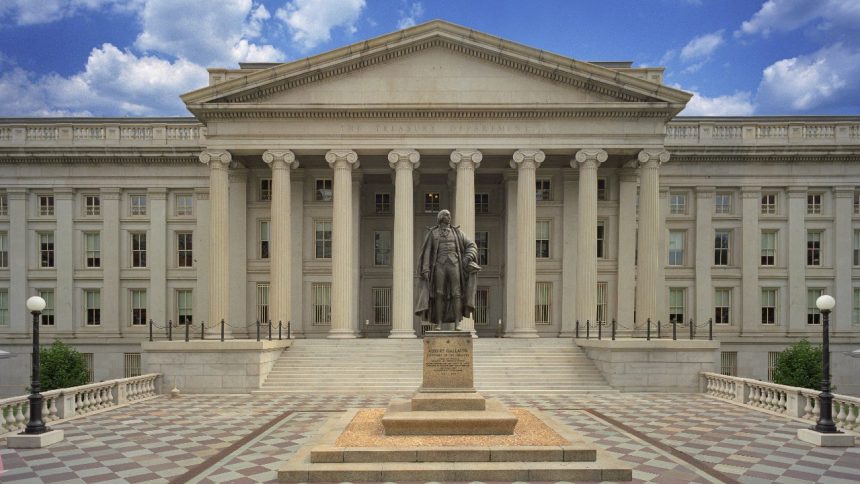Treasury bonds are government securities that have a 20-year or 30-year term, and they pay a fixed interest rate on a semi-annual basis. They earn interest until maturity and the owner is also paid a par amount, or the principal, when the Treasury bond matures. This interest is exempt from state and local taxes, but it’s subject to federal income tax, according to TreasuryDirect.
Treasurys are marketable securities, so they can be sold before maturity – unlike U.S. savings bonds, which are non-marketable securities and are issued and registered to a specific owner and can’t be sold in the secondary financial market.
What Treasury bonds pay in interest
Let’s run through an example of how Treasury bonds work and what they could pay you.
Imagine a 30-year U.S. Treasury Bond is paying around a 3 percent coupon rate. That means the bond will pay $30 per year for every $1,000 in face value (par value) that you own. So the semiannual coupon payments are half that, or $15 per $1,000.
Interest payments are made directly into your TreasuryDirect.gov account, if you use it to hold your securities. If you hold your bonds at a brokerage, then the interest payment will go there.
The yield on 30-year Treasury bonds is around 4.25 percent, as of April 2024.
When a Treasury bond is issued, the coupon rate stays fixed for the life of the bond, but the bond’s price can change as it’s traded in the market. If the bond price goes up, then its yield goes lower, even though the coupon rate remains the same. Conversely, if the bond price falls, the yield will go up, even though the coupon rate remains the same. Either way, when the bond matures, you’ll receive the face value of the bond back.
If the coupon rate is higher than the yield, that means the bond is selling at a premium, says Greg McBride, CFA, Bankrate chief financial analyst.
With a stock, you know what the price is today but you don’t know its future value. But with a bond you know what the end value is going to be when it matures, McBride says.
“If the price now is above the face value, then your yield is going to be less than the coupon rate because you may have paid $110 for the bond, it’s going to mature at $100,” McBride says. “Conversely, if you buy it for less than face value, your yield to maturity is going to be higher than the coupon rate. Because at maturity, that bond you paid $95 for is now going to give you $100.”
How to buy Treasury bonds
Investors have two major ways to buy Treasury bonds:
- Buy new bonds straight from the U.S. Treasury, a bank or a broker
- Buy existing bonds from the bond exchange through a bank or broker
You can buy Treasury bonds electronically from TreasuryDirect through non-competitive bidding. Non-competitive bidding means that you agree to accept the yield determined at auction and you’re guaranteed to receive both the amount and specific bond you want.
T-bonds can also be bought through banks, brokers or dealers through either a competitive or non-competitive bid. In a competitive bid, you specify the yield that you’ll accept and you may or may not get the bond you want. If you do receive the Treasury bond, it may be a smaller amount than what you requested.
Treasury bond auctions happen four times a year: in February, May, August and November. You must purchase at least $100 worth of Treasury bonds and they are sold in $100 increments. The maximum amount of Treasury bonds you may buy in a single auction is $10 million during non-competitive bidding or 35 percent of the initial offering amount via competitive bidding.
Of course, because Treasury bonds are traded on an exchange, you can also buy them at any time the market is open through a broker or bank offering such services. Those bonds won’t be new, but that’s largely irrelevant.
Who should invest in Treasury bonds?
Treasury bonds might be a good fit for someone who seeks safety, because Treasury securities are backed by the “full faith and credit” of the U.S. government. U.S. Treasury bonds are the de facto safe-haven investment for investors, McBride says.
“So when the stock market goes down, you’ll often see investors flocking to the safety of Treasurys,” McBride says.
Investors are often looking for the safety that bonds provide, and are less concerned with the yield.
Treasury bonds may also be an option to diversify your portfolio, if you’re heavily invested in stocks, for example. They tend to reduce the volatility of a portfolio, and usually fluctuate much less than stocks, which are well-known for their volatility. By diversifying your portfolio, you can smoothen your returns and reduce the overall risk in your portfolio.
But that doesn’t mean bonds are a good choice in all situations, particularly when the interest rate on bonds is very low. Then bonds may actually be risky.
Treasury bond risks
While Treasury bonds don’t have a serious risk that the government won’t pay you back, they do have two other risks that are typical of bonds: inflation risk and interest rate risk.
While Treasury bonds are relatively safe investments, one key risk is that inflation will erode your returns over the years. When you get the bond’s face value back, it won’t have the same purchasing power that it did 20 or 30 years earlier.
A 30-year Treasury bond yields about 4.25 percent (as of April 2024). If that yield is not higher than inflation, then your investment loses purchasing power.
“Investors should plan on inflation over the next 30 years averaging around 3 percent,” McBride says.
McBride says that in three decades, $1,000 will only have the buying power of $476, if inflation averages 2.5 percent over that period. As of April 2024, the inflation rate is about 3.5 percent.
“So, this is not something that’s going to grow your buying power or your wealth in any meaningful way,” McBride says. “And you’ve got tremendous interest rate risk if, for some reason, you need to sell prior to maturity.”
Interest rate risk is the risk that rates move adversely. If rates rise, then the price of your bond will decline. That may not be a problem if you don’t have to sell your bond before maturity. But if you want or need to sell it, then you won’t be able to sell it for face value, but maybe much less. And the longer your maturity, the more the bond will be affected by changes in interest rates.
Rising rates have impacted bond prices in recent years, McBride says.
Do Treasury bonds pay high interest?
A number of other Treasury securities (such as Treasury bills) are paying the highest yields in over a decade. Treasury bond yields have also risen in recent years.
Investors are demanding higher returns because of the rise in inflation, McBride says.
Many people like the safety offered by investing in Treasury bonds, which are backed by the U.S. government. But that safety comes at a cost – a lower coupon rate. Investors looking for higher interest payments might turn to corporate bonds, which typically yield more. But they’ll have to take on some extra risk for that extra return.
Buying a bond issued by one of the top companies may be relatively low risk, but it’s still not as low risk as buying a U.S. government bond. And corporate bonds can range from relatively safe to extremely risky, so you need to know what you’re purchasing if you buy them.
Some government bonds tied to inflation have started paying higher rates to account for increasing costs. Government-issued Series I bonds purchased between November 2023 and April 2024 will pay interest at an annual rate of 5.27 percent, according to TreasuryDirect. The interest rate on I bonds is tied to inflation and changes every six months.
Another option are Treasury Inflation Protected Securities (TIPS), which are Treasury securities designed to preserve the investor’s purchasing power.
“The price of the bond is adjusted relative to change in the Consumer Price Index,” McBride says.
For TIPS, as the price of the bond goes up, so too does the amount of the coupon. Over the bond’s lifetime, between the upward adjustments to the price of the bond and the increasing dollar amount of the coupon, it preserves the investor’s buying power, McBride says.
Are Treasury bonds a good investment?
Whether or not Treasury bonds are a good investment depends on your own financial situation.
For people who are risk averse and desire the safety of bonds sold by the U.S. government, they might be a good fit. But for those saving for long-term investing goals such as retirement, Treasury bonds are unlikely to provide a high enough return to meet your goals or even outpace inflation.
Those looking for a low-risk investment might also consider high-yield savings accounts or certificates of deposit offered by banks backed by the Federal Deposit Insurance Corp. (FDIC). Your money’s protected from a bank failure, if it’s within FDIC limits and guidelines.
These accounts pay an annual percentage yield (APY) that will reflect the overall interest rate level, but you’ll have fast access to cash in a high-yield savings account, and you can ladder CDs to potentially take advantage of an increase in interest rates.
Those looking for higher long-term returns will likely need to turn to stocks or stock funds for at least a portion of their portfolio. These investments are regularly among the best long-term investments, and they allow you to outpace inflation and grow your purchasing power over time.
Note: Bankrate’s Rachel Christian also contributed to this story.
Read the full article here
















